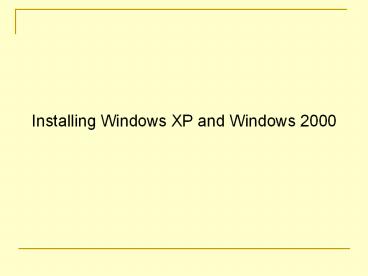Installing Windows XP and Windows 2000 PowerPoint PPT Presentation
1 / 7
Title: Installing Windows XP and Windows 2000
1
Installing Windows XP and Windows 2000
2
Installing two different versions of Windows on
the same machine. In this example, Windows 2000
and Windows XP will be installed.
- SYSTEM REQUIREMENTS
- A hard disk with at least 20G total capacity
(with up to 1.5 G for use during installation) - Processor with minimum 400 MHz clock speed
- At least 128 MB RAM
- Super VGA (800 x 600) video adapter and monitor
- CD-ROM/DVD drive
- Keyboard and compatible pointing device
3
PRELIMINARY CONSIDERATIONS
- Install the most recent OS last. In this case,
install Windows 2000 and then install Windows XP.
This prevents overwriting newer information by
older information, which may lead to a failed
installation. - Install each operating system on its own
partition (along with required applications). - Though not strictly required for installing Win
2o00/XP as the installation provides this option
during installation, partitioning the hard disk
using fdisk is another option that could be used
this, however is much more complicated.
Nonetheless, the next slide introduces this
concept.
4
USING FDISK
- To partition a drive using fdisk
- Step 1
- Have the boot disk available
- Change the BIOS to boot from floppy
- Insert the boot disk into the floppy drive and
restart the computer. - When the system finishes the startup or boot
process, the MS-DOS prompt appears on the screen
(A\gt ) - At this prompt, type and enter
- fdisk
- At the resulting screen (asking about large hard
disk support), type Y since we want to format
this partition FAT32 for later conversion to NTFS - Step 2
- The following website has an excellent procedure
that is easy to follow - http//www.onecomputerguy.com/install/fdisk.htm
- It is VERY IMPORTANT to backup any files on the
hard drive if this hard drive is not completely
blank. Fdisk will permanently erase any
information on that disk. - Using fdisk also requires a decision as to the
type of file system it will be. That is, fdisk
only partitions systems as FAT16, or FAT32. - Because this installation is for Windows 2000 and
XP, which are based on the NTFS, it is necessary
to choose FAT32. It may, however, be a good idea
to keep a third partition and format this FAT16.
5
INSTALLING WINDOWS 2000
- Change boot priority settings in the BIOS to boot
from the CD drive - Insert the Windows 2000 installation CD in the
drive and exit the BIOS - When the computer restarts, the Setup program
from the CD loads installation files and the
"Welcome to Setup" screen opens, press Enter to
begin installation - Press F8 to accept the License Agreement screen
- The Disk Partitions window opens displaying
available partitions and unused space on the hard
drive. Assuming the hard disk is completely
blank, select C to create a new partition and
specify its size according to the minimum
requirements of this OS. - After selecting a partition, the Disk Formatting
window opens, accept the default of NTFS format. - The next stages of the installation are GUI
interfaced and will require following the
onscreen instructions. Ensure the product key is
nearby as it will be requested during this phase
of installation.
6
INSTALLING WINDOWS 2000
- After installation is complete, click Finish and
remove the CD. The computer restarts
automatically. - Test the installation by logging on with the
password created during installation and then
shutting down. - Note Do not change the BIOS as the next step is
to install Windows XP, and the first step is to
boot from the CD. - Installing Windows XP follow the same steps and
these will not be repeated. The only difference
is to ensure to install the OS on either the
unused partition or to specify a size and create
a new one. - In addition, upon completion of that
installation, ensure boot priority in the BIOS is
reset to boot from the hard drive. - The next step is to specify boot order and
testing that the installations were successful is
indicated by - Both OSs appearing in the boot loader menu
- Successful log in to either OS
7
SPECIFYING THE DEFAULT OPERATING SYSTEM FOR
STARTUP
- Navigate to Control Panel, click System.
- On the Advanced tab, under Startup and Recovery,
click Settings. - Under System startup, in the Default operating
system list, click the operating system that you
want to start when you turn on or restart your
computer. - Select the Display list of operating systems for
check box, and then type the number of seconds
for which you want the list displayed before the
default operating system starts automatically.

